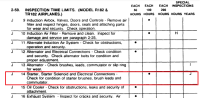morleyz
Pre-takeoff checklist
Went out to take a spin in my '72 Piper Arrow II. Pre-flight, roll it out onto the apron, go to start and nothing. Not even a prop wiggle. Threw the jump starter on it to see if maybe I had a bad battery, nothing. Pushed her back into the hangar and did some troubleshooting.
- Starting circuit breaker not popped
- Removed cowl and in the hangar I can clearly hear the solenoid clicking. Voltage at the ship side of the solenoid is 13.8. When "cranking", it drops under 13V measured at the starter side of the solenoid.
- No whirring sound from the starter (I read this is what you would hear in a bendix failure)
- I marked the starter gear with a red sharpie. Doesn't seem to be turning (or I miraculously got it to stop every single time in the exact same spot)
- I can easily turn the shaft by hand
- When cranking, lights dim, etc. so something is drawing a good load
- Just for grins, it was suggested in the service manual to jumper the solenoid, so I did try this with some #4 battery cable, still not a click or a wiggle from the starter
Never had a slow start or a failed start before and I was out about 8 days ago without issue.
Is there anything else I should check before declaring the starter dead? If it is dead, despite the ridiculous cost, I will go with an upgraded Skytec unit vs. direct OEM replacement/rebuild of my unit, but figured I'd save me some $$ on the labor if I scheduled an A&P for a replacement and had the unit ready rather than a diagnostic.
- Starting circuit breaker not popped
- Removed cowl and in the hangar I can clearly hear the solenoid clicking. Voltage at the ship side of the solenoid is 13.8. When "cranking", it drops under 13V measured at the starter side of the solenoid.
- No whirring sound from the starter (I read this is what you would hear in a bendix failure)
- I marked the starter gear with a red sharpie. Doesn't seem to be turning (or I miraculously got it to stop every single time in the exact same spot)
- I can easily turn the shaft by hand
- When cranking, lights dim, etc. so something is drawing a good load
- Just for grins, it was suggested in the service manual to jumper the solenoid, so I did try this with some #4 battery cable, still not a click or a wiggle from the starter
Never had a slow start or a failed start before and I was out about 8 days ago without issue.
Is there anything else I should check before declaring the starter dead? If it is dead, despite the ridiculous cost, I will go with an upgraded Skytec unit vs. direct OEM replacement/rebuild of my unit, but figured I'd save me some $$ on the labor if I scheduled an A&P for a replacement and had the unit ready rather than a diagnostic.



